Abu Ghraib
aka Abu Ghurayb, Abu Grhaib
 The White House really wants you to know all about the atrocities that happened at Abu Ghraib... all of the ones that happened before 2003.
The White House really wants you to know all about the atrocities that happened at Abu Ghraib... all of the ones that happened before 2003.
The White House's Web site features a charming little page called Tales of Saddam's Brutality. Posted in September 2003, the idea behind the page was simple: Overwhelm people with visceral stories of evil Saddam Hussein, in order to prop up an increasingly unpopular invasion of Iraq that was originally based on the idea that Saddam was hoarding weapons of mass destruction.
By fall 2003, it was starting to look like those weapons were never going to show up, so the Bush administration began unsubtly revising history to reflect the fact that the U.S. went into Iraq to get rid of "a bad man."
After all, no one in George Bush's America would dare suggest that the Iraqi people weren't better off with Saddam out of the way. And Saddam and Sons were indeed pretty atrocious, in the strictly literal sense of authoring atrocities.
Indeed, the evidence was all there, in the Tales. Perhaps they finally learned their lesson about taking information from the CIA, because the Tales were all carefully culled from newspaper and media reports:
"We visited the notorious Abu Gehb (sic) Prison outside Baghdad and found written records of prisoners being executed by being put through mincing machines."
"Saddam Hussein never cut corners when it came to punishment. Abu Ghraib once held tens of thousands of human souls -- criminals, political enemies, and those who just happened to get in the way. A 12-year-old Iranian boy visiting his grandmother near Basra in 1985 was swept up in an Iraqi invasion. He was still here 15 years later."
"I saw three guards beat a man to death with sticks and cables," one prisoner remembered. "When they got tired, the guards would switch with other guards. I could only watch for a minute without getting caught, but I heard the screams, and it went on for an hour."
"Our hands were tied like this. First the left hand and then the foot. Then a
black hood on my head, then they applied electricity."
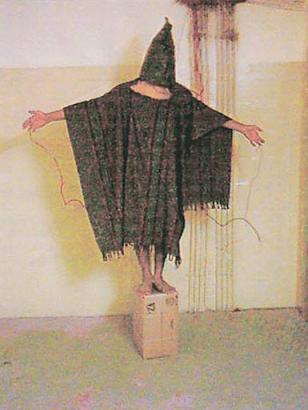 The last entry is particularly piquant in light of the picture (right) showing U.S. soldiers doing exactly the same thing to an Iraqi prisoner.
The last entry is particularly piquant in light of the picture (right) showing U.S. soldiers doing exactly the same thing to an Iraqi prisoner.
Abu Ghraib (pronounced "grayb") is a sprawling 280-acre gulag, complete with sniper towers and razor wire, dungeons and the stench of human fear.
According to U.S. State Department propaganda released in April 2003 to justify the march toward war, Saddam killed 4,000 prisoners at the institution in 1984, and executed fewer 50 political prisoners there between 2000 and 2001. You'd think that this represented progress, but to the U.S. it was a reason to invade (retroactively).
Based on all this copious evidence of brutality at Abu Ghraib, the moral case for getting rid of Saddam seemed like a "slam dunk," as George Tenet might say. What could possibly go wrong?
"No one can argue that the Iraqi people would be better off with the thugs and murderers back in the palaces," Bush said as recently as March 2004, by which time he should have known better. Because two months earlier, the other shoe had dropped.
When the U.S. came storming into the country in spring of 2003, Abu Ghraib was left a smoldering ruin, looted by the local populace as the Saddam regime disintegrated. The Americans came in and thought to themselves, "Hey, wouldn't it be great if we used this ghoulish house of horrors for our own prison?" You can almost imagine them thinking to themselves, "Gee, then people will see how much better we are than those lousy Baathists!"
 Actually, you need not imagine it. When the prison made its debut as an American institution, Gen. Janis Karpinski came right out and said it. "Living conditions (for the prisoners) now are better in prison than at home. At one point we were concerned that they wouldn't want to leave,” the general boasted.
Actually, you need not imagine it. When the prison made its debut as an American institution, Gen. Janis Karpinski came right out and said it. "Living conditions (for the prisoners) now are better in prison than at home. At one point we were concerned that they wouldn't want to leave,” the general boasted.
Let that be a lesson to you all: Never boast.
The prison had held a peak population of around 15,000 under Saddam. The Americans humanely reduced that number to about 5,000. And in place of Saddam's humiliation and torture, the Americans humanely substituted... Well, more humiliation and torture.
According to a "for internal use only" army report, from October to December 2003, U.S. soldiers performed a laundry list of degrading abuses on prisoners at Abu Ghraib. The report offers up the most hardcore details in a U.S. government document since the Starr Report, only much, much uglier. It's hard to actually appreciate the severity of what happened from the sound bites on the evening news (although the pictures get it across pretty well). For a sense of scale, however, try reading the complete list. And remember, this is just what the military could confirm as having happened:
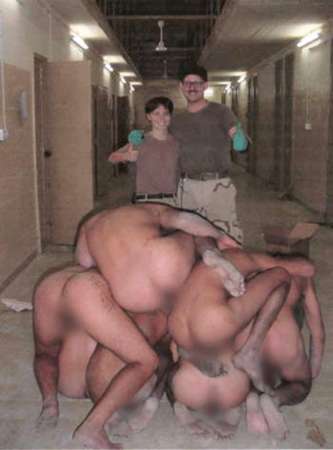
a. (S) Punching, slapping, and kicking detainees; jumping on their naked feet;
b. (S) Videotaping and photographing naked male and female detainees;
c. (S) Forcibly arranging detainees in various sexually explicit positions for
photographing;
d. (S) Forcing detainees to remove their clothing and keeping them naked for several days at a time;
e. (S) Forcing naked male detainees to wear women's underwear;
f. (S) Forcing groups of male detainees to masturbate themselves while being
photographed and videotaped;
g. (S) Arranging naked male detainees in a pile and then jumping on them;
h. (S) Positioning a naked detainee on a MRE Box, with a sandbag on his head, and attaching wires to his fingers, toes, and penis to simulate electric torture;
i. (S) Writing "I am a Rapest" (sic) on the leg of a detainee alleged to have forcibly raped a 15-year old fellow detainee, and then photographing him naked;
j. (S) Placing a dog chain or strap around a naked detainee's neck and having a
female Soldier pose for a picture;
k. (S) A male MP guard having sex with a female detainee;
l. (S) Using military working dogs (without muzzles) to intimidate and frighten
detainees, and in at least one case biting and severely injuring a detainee;
m. (S) Taking photographs of dead Iraqi detainees.
a. (U) Breaking chemical lights and pouring the phosphoric liquid on detainees;
b. (U) Threatening detainees with a charged 9mm pistol;
c. (U) Pouring cold water on naked detainees;
d. (U) Beating detainees with a broom handle and a chair;
e. (U) Threatening male detainees with rape;
f. (U) Allowing a military police guard to stitch the wound of a detainee who was
injured after being slammed against the wall in his cell;
g. (U) Sodomizing a detainee with a chemical light and perhaps a broom stick.
h. (U) Using military working dogs to frighten and intimidate detainees with threats of attack, and in one instance actually biting a detainee.
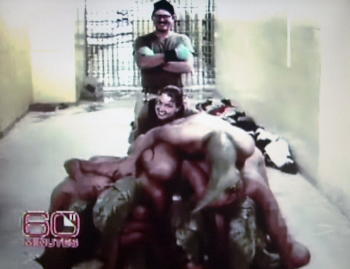 According to the report, which is a summary of the military's internal investigation of the abuses, soldiers testified that they had been ordered to abuse the prisoners, to prepare them for interrogation.
According to the report, which is a summary of the military's internal investigation of the abuses, soldiers testified that they had been ordered to abuse the prisoners, to prepare them for interrogation.
These orders allegedly came from both military intelligence officers and civilian consultants -- members of that class of Iraq warrior ever-so-euphemistically referred to as "private contractors," which is Pentagon-speak for paid mercenaries and "security" experts.
Perhaps needless to say, whatever orders the servicemen and women received with respect to "softening up" the prisoners for interrogation, it's highly unlikely that anyone ordered them to take the garish, jackal-grinning snapshots that have earned them a permanent place in the archives of disturbing illustration.
Needless to say, this uniquely American problem required a uniquely American response. The first impulse, as always, was to cover it up. So the military commissioned a report on the abuses, secretly reassigned and charged several enlisted people who had allegedly taken part in the abovementioned sadistic acts. The commanders were discreetly reprimanded and reassigned. The contractors... Well, nothing was done to the contractors, who may actually escape without any punishment, since it's possible there isn't a law with jurisdiction over their activities. Isn't that convenient?
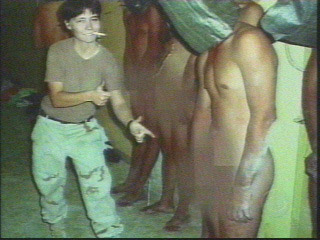 Unfortunately, there was the little matter of the report. And the pictures. Especially the pictures. During one of their epic rounds of sexual abuse, a group of male and female soldiers came up with the bright idea to take some photos, souvenirs for their friends and loved ones back home.
Unfortunately, there was the little matter of the report. And the pictures. Especially the pictures. During one of their epic rounds of sexual abuse, a group of male and female soldiers came up with the bright idea to take some photos, souvenirs for their friends and loved ones back home.
It's really, really hard to imagine how someone could think it was a good idea to document this activity, but then it's pretty clear from the pictures that we aren't exactly dealing with the intellectual elite of the Iraqi prison system. (Among other clues, they misspelled "rapist" at least two different ways when they were scrawling it on the bodies of their victims with magic marker.)
In the snapshots, smirking soldiers gawk and point at the genitalia of naked Iraqi men. In some pictures, the prisoners are forced to simulate sex with each other. In others, they're just piled on top of each other. In almost all the pictures released to date, they're naked. According to news media reports, there are probably more pictures which have yet to surface.
The report itself was pretty newsworthy, but the pictures ensured that the story would go large. Despite what would seem like an obvious concern, the Army sat on the report and did nothing about it for months -- not even after they knew the media was preparing to publish the photos.
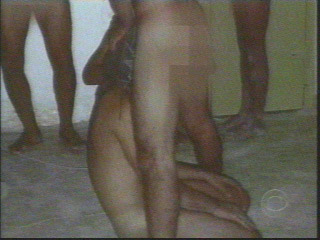 For two weeks, 60 Minutes II even held off running the story at the request of General Richard Myers, chairman of the Joint Chiefs of Staff. What did Myers do during those two weeks? On the surface, it appears he did nothing at all to prepare for the coming PR crisis... But then, maybe he was making the other, really bad photos that no one knows about disappear.
For two weeks, 60 Minutes II even held off running the story at the request of General Richard Myers, chairman of the Joint Chiefs of Staff. What did Myers do during those two weeks? On the surface, it appears he did nothing at all to prepare for the coming PR crisis... But then, maybe he was making the other, really bad photos that no one knows about disappear.
We leave it to the reader to judge what kind of news organization holds off on publishing an expose of the Army at the Army's request, but CBS agreed to delay its broadcast for two weeks. The New Yorker rang in hard on the heels of the CBS report with an incredibly detailed and damaging story that featured extensive excerpts from the report quoted above.
It's still too early to know where the buck is going to stop on this story, but the odds are very good that the scandal has only just begun. Since the story came out, a slew of new stories have broken with claims that U.S. captors have murdered at least two prisoners. (That's not an editorial opinion; the army characterizes the deaths as "homicides.") And a Senate inquiry panel is already in the works, which means lots of big, fat, ugly, televised hearings.
Almost a week after the 60 Minutes report broke, Donald Rumsfeld incredibly told reporters that he hadn't even read the Army's own report on the incident, which should tell you exactly how pathetic this is going to get before it's all over. Also among those who were claiming they hadn't read the report during the first week of the public crisis are President Bush, the commander of the Army in Iraq and General Myers, the same guy who begged 60 Minutes II not to run the photos a month ago. Hell, it's possible Dick Cheney still hasn't even heard about the story around the water cooler yet!
UPDATE: On Friday, May 7, 2004, Rumsfeld told a Senate panel that videotapes of the abuse at Abu Ghraib also exist. According to the New Yorker's Sy Hersh, the tapes include footage of male minor prisoners being raped. Senator Lindsey Graham told reporters after the session that additional allegations of "rape and murder" are forthcoming. You might want to settle in for a long, election-cycle scandal, the likes of which this nation has never seen...
External link: Tales of Saddam's Brutality at whitehouse.gov
Timeline
| 1984 |
According to statistics furnished by the White House, a total of 4,000 Iraqis are summarily executed at Abu Ghraib on orders of Saddam Hussein. |
| Feb-Mar 2000 |
According to statistics furnished by the White House, a total of 120 Iraqi political prisoners are executed at Abu Ghraib on orders of Saddam Hussein. |
| Oct 2001 |
According to statistics furnished by the White House, 23 Iraqi political prisoners are executed at Abu Ghraib on orders of Saddam Hussein. |
| Jun 2003 |
The Army assigns Brigadier General Janice Karpinski to oversee Abu Ghraib prison, which has been renamed the Baghdad Central Correctional Facility. |
| Sep 2003 |
Brigadier General Janice Karpinski gives a tour of the Abu Ghraib prison facility to Defense Secretary Donald Rumsfeld. She points out that Saddam Hussein used the prison to torture his enemies, whereas the Americans don't. |
| Oct 2003 |
During an interview at Abu Ghraib prison with 60 Minutes correspondent Steve Kroft, Brigadier General Janice Karpinski declares: "This is international standards. It's the best care available for -- in a prison facility." |
| 8 Oct 2003 |
At a Republican party gala at the Washington Hilton, President George W Bush proclaims: "Iraq is free of rape rooms and torture chambers." |
| 6 Nov 2003 |
After receiving uncomfortable Red Cross reports regarding abuses in the Abu Ghraib Prison, the U.S. military responds by issuing new requirements that appointments be made before any inspections to the particular cellblocks in which the worst abuses occurred. Note that by the rules of the Geneva Conventions, the Red Cross may visit any part of the prison without any prior notification. [The New York Times, 19 May 2004.] |
| 14 Dec 2003 |
During an interview at Abu Ghraib prison with a St. Petersburg Times reporter, Brigadier General Janice Karpinski declares: "Living conditions now are better in prison than at home... At one point we were concerned they wouldn't want to leave." |
| 14 Jan 2004 |
Military investigators question Army Reserves Staff Sgt. Ivan "Chip" Frederick regarding his role in the Abu Ghraib incidents. As a reservist, Frederick has a civilian job back home in Virginia, where he worked for six years as a state prison guard at Buckingham Correctional Center. |
| 29 Apr 2004 |
CBS television broadcasts photographs taken of Iraqi prisoners being mindfucked and sexually humiliated at the hands of US troops in Abu Ghraib prison. "60 Minutes II has a dozen of these pictures, and there are many more -- pictures that show Americans, men and women in military uniforms, posing with naked Iraqi prisoners." |
| 29 Apr 2004 |
A reporter for the Baltimore Sun shows some of the Abu Ghraib photos to Terrie England, who immediately recognizes her daughter Lynndie R. England as one of the soldiers. The mother then dismisses what she sees in the pictures as nothing more than "stupid kid things -- pranks." |
| 30 Apr 2004 |
During a photo op in the White House rose garden with Canadian Prime Minister Paul Martin, President George W Bush insists: "Their treatment does not reflect the nature of the American people. That's not the way we do things in America. And so I -- I didn't like it one bit." |
| 30 Apr 2004 |
During a briefing with the White House press corps, spokesman Scott McClellan thwarts a reporter's attempts to ascertain when the President first learned of the crimes:
| REPORTER: |
How long has the President been aware of the evidence of prisoner abuse at Abu Ghraib prison? |
| MCCLELLAN: |
Well, there were allegations that go back quite some time here, Terry. And that's why you already have the military pursuing some criminal charges against some individuals. |
| REPORTER: |
Had the President seen these photographs before two nights ago? |
| MCCLELLAN: |
I don't know the exact time when he saw the photographs. I mean, they've certainly been in the media the last couple of days. |
|
| 30 Apr 2004 |
The New Yorker runs a piece by Seymour Hersh detailing other abuses at Abu Ghraib. |
| 6 May 2004 |
Radio commentator Rush Limbaugh dismisses the photos taken of naked prisoners at Abu Ghraib prison, saying: "This is no different than what happens at the Skull and Bones initiation." |
| 7 May 2004 |
Testifying before a Senate panel, Donald Rumsfeld confirms that videotapes of abuses at Abu Ghraib have yet to be released, as well as numerous additional photos. Also extant are videotapes taken by U.S. soldiers of Iraqi guards raping young boys. |
| 12 May 2004 |
A "secret room" at the U.S. Senate becomes an adult theatre between the hours of 2 and 5 PM as unreleased torture pictures, forced-sodomy pictures, and numerous sex pictures allegedly involving Lynndie England are displayed to Congressmen in a government slide show.
|
| 14 May 2004 |
Piers Morgan, editor of England's Daily Mirror newspaper, steps down after criticism over that publication's printing of Abu Ghraib style "torture photos" which actually originated on porn sites created by spammers during the early days of the Afghan and Iraq Wars. Another publication fooled by similar photos was the Boston Globe.
|
| 21 May 2004 |
In an interview with Australia's 60 Minutes, Deputy Secretary of State Richard L. Armitage declares: "If you're talking about Abu Ghraib and the abuse there, it doesn't intrigue me at all; it horrifies me. And it seemed to me that we had a command climate there that was conducive to this kind of bad behavior. And nobody was taking normal corrective actions, no one was exercising command, and I find that a horrifying specter and I couldn't be angrier about it, and I couldn't be sorrier about it."
|
| 24 May 2004 |
In a speech at the Army War College in Carlisle, Pennsylvania, President George W Bush announces: "A new Iraq will also need a humane, well-supervised prison system. Under the dictator, prisons like Abu Ghraib were symbols of death and torture. That same prison became a symbol of disgraceful conduct by a few American troops who dishonored our country and disregarded our values. America will fund the construction of a modern maximum security prison. When that prison is completed, detainees at Abu Ghraib will be relocated. Then, with the approval of the Iraqi government, we will demolish the Abu Ghraib Prison as a fitting symbol of Iraq's new beginning."
|
| 24 May 2004 |
See no evil: Donald Rumsfeld bans the use of cameras by the U.S. Military in Iraq. |
| 10 Jun 2004 |
During a press conference at the G8 Summit, President Bush is asked to clarify his administration's policies toward torture:
| REPORTER: |
Returning to the question of torture, if you knew a person was in U.S. custody and had specific information about an imminent terrorist attack that could kill hundreds or even thousands of Americans, would you authorize the use of any means necessary to get that information and to save those lives? |
| BUSH: |
Jonathan, what I've authorized is that we stay within U.S. law. |
|
[...] |
| REPORTER: |
Mr. President, I wanted to return to the question of torture. What we've learned from these memos this week is that the Department of Justice lawyers and the Pentagon lawyers have essentially worked out a way that U.S. officials can torture detainees without running afoul of the law. So when you say that you want the U.S. to adhere to international and U.S. laws, that's not very comforting. This is a moral question: Is torture ever justified? |
| BUSH: |
Look, I'm going to say it one more time. If I -- maybe -- maybe I can be more clear. The instructions went out to our people to adhere to law. That ought to comfort you. We're a nation of law. We adhere to laws. We have laws on the books. You might look at those laws, and that might provide comfort for you. And those were the instructions out of -- from me to the government. |
|
| 26 Aug 2004 |
During a stop in Phoenix, Arizona, Defense Secretary Donald Rumsfeld grants an interview to Real Life with David Leibowitz on KTAR-AM 620. Regarding the findings of the most recent report on the Abu Ghraib scandal, Rumsfeld denies that any abuses occurred during interrogations:
| RUMSFELD: |
I think the interesting thing about the Schlesinger Panel is there a conclusion that, in fact, the abuses seem not to have anything to do with interrogation at all and any suggestion to the contrary, it would seem to me, would be incorrect given what we know at the present time, as a result of their report. These were apparently acts of abuse that took place not in the context of interrogating people[...] |
| LEIBOWITZ: |
But doesn’t the report indicate that there are military intelligence officers, 27 of them involved here and civilian contractors and of course, some of these abuses happened under interrogation circumstances? |
| RUMSFELD: |
That’s not the report of the Schlesinger Panel. In fact, it’s exactly the opposite of what the Schlesinger Panel says. |
Actually, if you somehow manage to read all the way down to sentence 5 of paragraph 1 in the report, you'll find this: "[W]e do know that some of the egregious abuses at Abu Ghraib which were not photographed did occur during interrogation sessions and that abuses during interrogation sessions occurred elsewhere."
|
|
 The White House really wants you to know all about the atrocities that happened at Abu Ghraib... all of the ones that happened before 2003.
The White House really wants you to know all about the atrocities that happened at Abu Ghraib... all of the ones that happened before 2003.
 According to the report, which is a summary of the military's internal investigation of the abuses, soldiers testified that they had been ordered to abuse the prisoners, to prepare them for interrogation.
According to the report, which is a summary of the military's internal investigation of the abuses, soldiers testified that they had been ordered to abuse the prisoners, to prepare them for interrogation.  The last entry is particularly piquant in light of the picture (right) showing U.S. soldiers doing exactly the same thing to an Iraqi prisoner.
The last entry is particularly piquant in light of the picture (right) showing U.S. soldiers doing exactly the same thing to an Iraqi prisoner. Actually, you need not imagine it. When the prison made its debut as an American institution, Gen. Janis Karpinski came right out and said it. "Living conditions (for the prisoners) now are better in prison than at home. At one point we were concerned that they wouldn't want to leave,” the general boasted.
Actually, you need not imagine it. When the prison made its debut as an American institution, Gen. Janis Karpinski came right out and said it. "Living conditions (for the prisoners) now are better in prison than at home. At one point we were concerned that they wouldn't want to leave,” the general boasted. 
 Unfortunately, there was the little matter of the report. And the pictures. Especially the pictures. During one of their epic rounds of sexual abuse, a group of male and female soldiers came up with the bright idea to take some photos, souvenirs for their friends and loved ones back home.
Unfortunately, there was the little matter of the report. And the pictures. Especially the pictures. During one of their epic rounds of sexual abuse, a group of male and female soldiers came up with the bright idea to take some photos, souvenirs for their friends and loved ones back home.  For two weeks, 60 Minutes II even held off running the story at the request of General Richard Myers, chairman of the Joint Chiefs of Staff. What did Myers do during those two weeks? On the surface, it appears he did nothing at all to prepare for the coming PR crisis... But then, maybe he was making the other, really bad photos that no one knows about disappear.
For two weeks, 60 Minutes II even held off running the story at the request of General Richard Myers, chairman of the Joint Chiefs of Staff. What did Myers do during those two weeks? On the surface, it appears he did nothing at all to prepare for the coming PR crisis... But then, maybe he was making the other, really bad photos that no one knows about disappear.